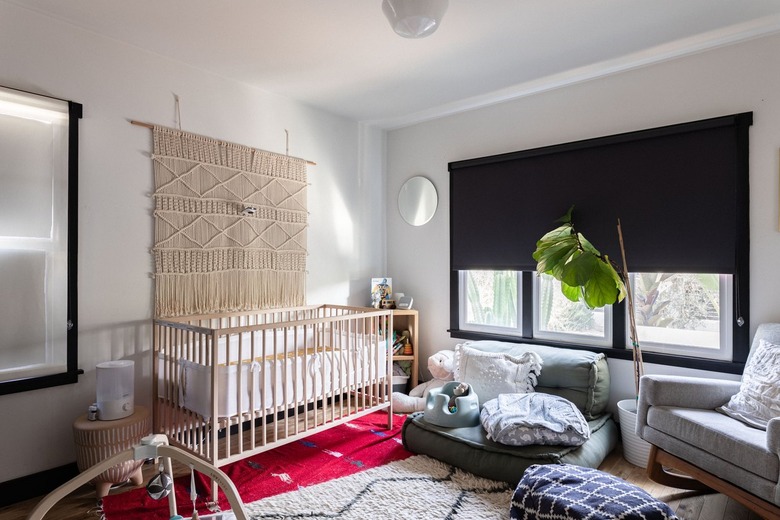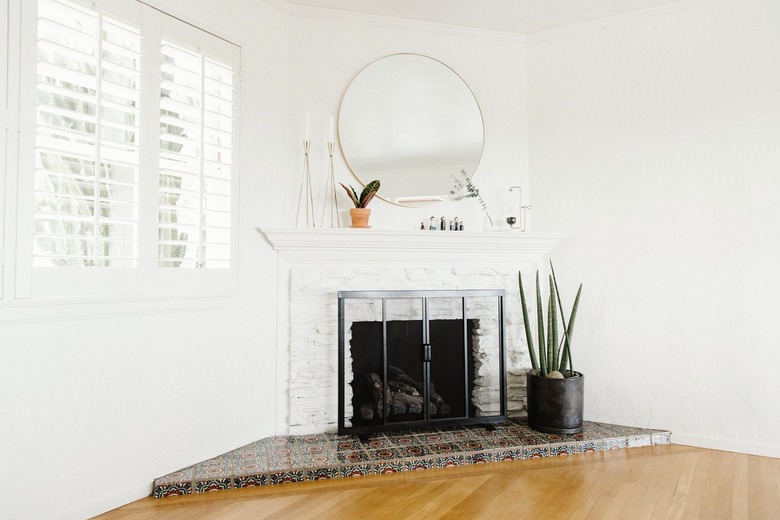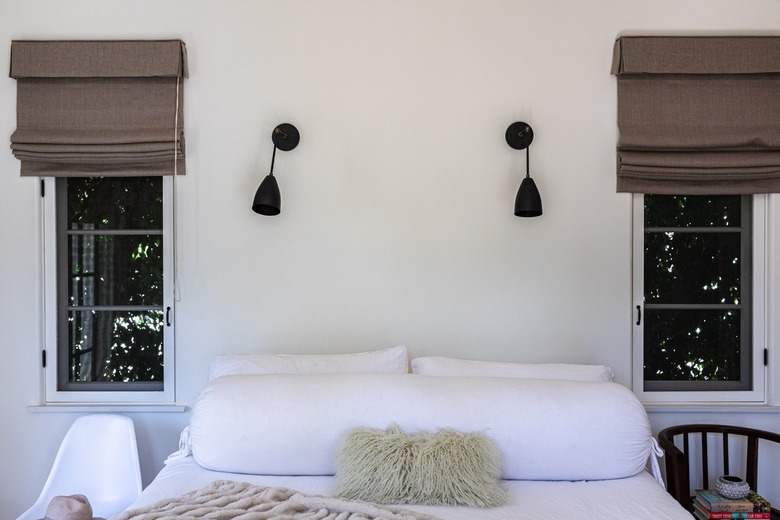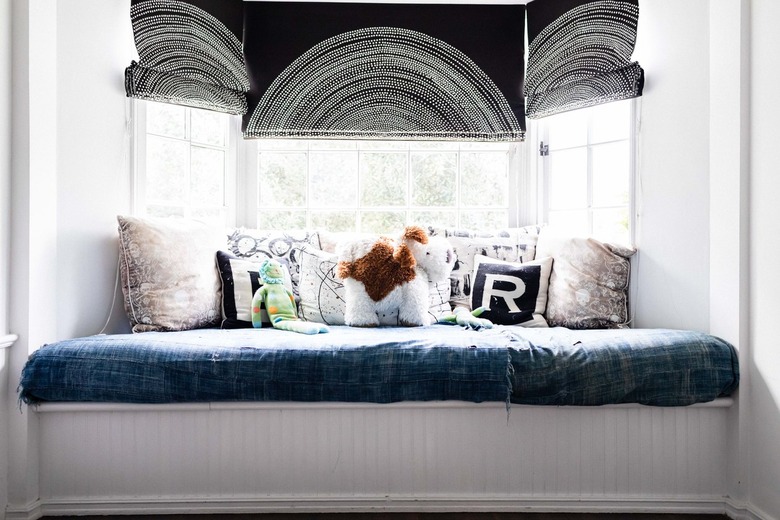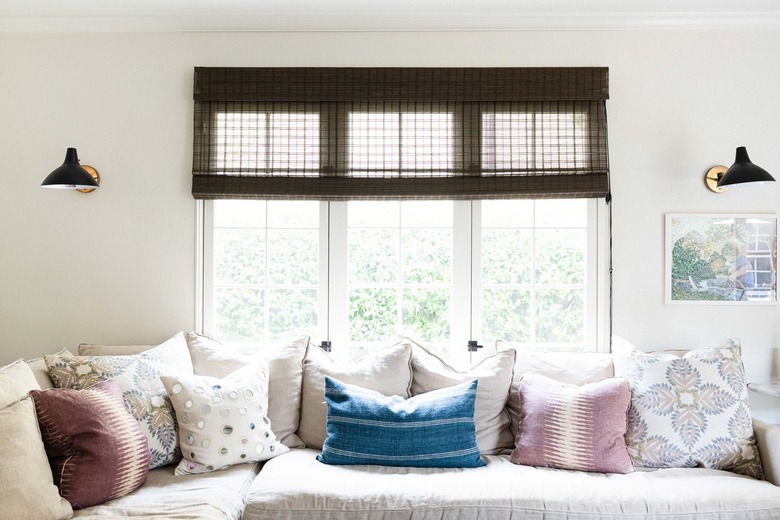The Ultimate Guide To Choosing The Right Blinds Or Shades
- What's the difference between shades and blinds?
- Common types of blinds
- Common shade styles
- Do you want to block out sunlight?
- Do you want to save on heating bills?
- Do you need a little privacy?
- Do you have kids or pets?
- Do you hate cleaning?
- Are you trying to save money?
- What style are you seeking?
Window treatments are a must for those who wish to control the amount of light in a room or add some privacy to a space. They can also transform the overall appearance of a room, not only adding a splash of color but creating a casual, cozy, formal, or even sleek feeling in the space. Because there are so many types of window blinds and shades available, it's important to consider what you want from your window coverings before choosing the right option for your space.
Ready to cover up your bare windows? Here's what you should consider before buying shades or blinds.
What’s the Difference Between Shades and Blinds?
What's the Difference Between Shades and Blinds?
The most basic distinction is that blinds have slats and shades don't. Beyond that, blinds are considered to be hard-material window treatments, meaning they are made from materials such as wood, metal, vinyl, faux wood, or stiff fabric. Shades are typically made from fabrics, giving them a softer look and feel, though just as blinds may be made from cotton, shades can be made from woven wood. Both options come in an array of colors, fabrics, and styles to suit any décor.
Because blinds have slats by nature, most styles allow for increased privacy while still allowing in light, but they do not keep light out as effectively as shades. Shades, on the other hand, can typically only be raised or lowered, making it more difficult to maintain privacy when letting in light, which is why shades are sometimes paired with other drapery, such as sheer curtains, so the shades can be opened and closed to adjust the light in the room while still maintaining privacy.
Common Types of Blinds
Common Types of Blinds
There are four basic types of blinds. They differ from one another based on how they hang, the size of the slats, and how they open.
- Venetian blinds: These have horizontal slats suspended
by cords and can be raised, tilted, or lowered to let the desired amount
of light into a room. The most popular material for Venetian blinds is wood or
faux wood. - Mini blinds: Similar to Venetian blinds, these feature more narrow slats that are
typically less than 1 inch wide. Mini blinds are most commonly made from vinyl or aluminum. - Vertical blinds: With long, wide slats that run vertically, these blinds are best
used for windows that are wider than they are tall, which is why they are the
most common window treatment for sliding glass doors. While they cannot be
raised out of the way, they are instead opened or closed like curtains and can
still be tilted to adjust the light levels in a room. Vertical blinds are
usually made from vinyl. - Panel blinds: Like vertical blinds in that they hang vertically, panel blinds are
unique in that they are made from large rectangles of fabric. These cannot be
rotated like other types of blinds. They instead slide back and forth on a
track, letting the user choose how wide to open the panels, similar
to shades.
Blinds typically come in one of five materials:
-
Wood may be polished, stained, painted,
or left with a more rough appearance. While wood can be used for all types of
blinds, it is most commonly used on Venetian blinds. -
Faux wood looks like wood only
the material is less expensive, more durable, and more moisture resistant than
real wood. Faux wood is useful for high humidity areas, like kitchens and
bathrooms. -
Aluminum comes in just about any
shade. For blinds that will last longer, buy aluminum blinds
made of thicker 8-gauge over the cheaper 6-gauge metal. -
Vinyl comes in an array of colors and
textures and is widely used for all types of blinds. -
Fabric, most commonly thick cotton, filters out
light but doesn't fully block it like other materials used in blinds. Fabric
is most commonly used in vertical or panel blinds, where it is weighted down to
hang straight.
Common Shade Styles
Common Shade Styles
When it comes to different shade styles, the main differences involve how the shades raise and the shape of the fabric. The five most common styles of shades are:
- Roller shades: These roll up neatly
at the top of the window and can be corded or cordless. While these
typically come in only two lengths, you can always cut an adjustable-size shade to fit. - Tie-up shades: These do not have a cord to roll them up and are instead manually adjusted and then secured by two pieces of fabric or string. These should
only be installed on windows where they do not need to be adjusted regularly
since doing so can be cumbersome. When the bottom is fitted on a rod that makes
them easier to roll up, they are known as Swedish shades or roll-up shades. - Roman shades: These raise into wide, folded pleats. Most lay flat, though
some create large billows, known as balloons, for a more dramatic appearance. - Pleated shades: These look similar to Venetian blinds only they are made with one
solid piece of accordion-folded material. - Honeycomb shades (also called cellular shades): These are like pleated shades, only
they have multiple layers of fabric (either two, three, or four layers of fabric with one, two, or three cells inside) that form pockets
shaped like a honeycomb. These shades are quite useful for filtering light as
well as insulating windows. Honeycomb shades have different lifting options
than other shades, and some can be lowered from the top down or lifted from the
bottom up, providing maximum privacy and light control.
Do You Want to Block Sunlight?
Do You Want to Block Sunlight?
When you want to keep sunlight out of your room, blackout shades are the way to go. While these are generally more expensive than conventional shades, they will allow you to fully block out the light from your windows. Blackout shades are available in all types of shade styles and are best used in bedrooms to keep out morning light.
If you don't want to fully eliminate the natural light entering your room but want to block UV rays that could damage your furniture or artwork or create a glare on your TV or computer screen, then you may instead consider solar shades. These are light-filtering shades that are sheer enough to allow some level of visibility outside while still keeping out direct sunlight. They are best used in south-facing rooms that get a lot of direct sunlight as well as in computer rooms or living rooms where glare can make it difficult to view your screen.
Do You Want to Save on Heating Bills?
Do You Want to Save on Heating Bills?
While blocking sunlight outright or even just blocking UV rays can help cool down your home, it won't necessarily do anything to help you with your heating costs. Though by nature thicker materials will help better insulate your home, if you really want to step up the insulation on your windows, invest in thermal shades. Thermal shades are made from a special insulating material that is meant to keep warm air inside your home. It's worth noting that when made in darker hues, these materials typically also work as blackout shades.
While thermal shades are available in all styles, the most effective are the honeycomb variety, which have built-in insulating properties since air is naturally trapped in their cellular structure. When using honeycomb shades, keep in mind that the more cells on the shades, the better the insulation. For best results, buy a three-celled honeycomb shade since each layer increases the insulation of the shades.
Do You Need a Little Privacy?
Do You Need a Little Privacy?
While blinds might not be as good at blocking light as shades, they excel when it comes to privacy since they can be tilted to allow in light while still covering the entire window to ensure privacy. The exception, of course, is panel blinds, which cannot be tilted.
Unfortunately, when it comes to shades, all but the most sheer versions prevent you from looking outside or from letting in light unless you open the window coverings entirely. However, very sheer materials or solar shades should work just fine. As an alternative, honeycomb shades that open and close from the top and bottom can operate like café curtains to allow you to let in light at the top of the window while making it difficult for people to see what's happening through the bottom half.
Do You Have Kids or Pets?
Do You Have Kids or Pets?
The cords on shades and blinds are notoriously dangerous for young children and pets, who can get tangled and strangle to death. In fact, both the United States and Canada have prohibited the sale of new window treatments with long cords unless ordered as a custom-made product. If you're buying custom-made or used window treatments, be sure to purchase models with short or inaccessible cords or those that are cordless. All new, commercially sold blinds and shades should be sold with one of these options already.
Do You Hate Cleaning?
Do You Hate Cleaning?
Unfortunately, there is no way to completely avoid cleaning either blinds or shades since both are notorious dust magnets. Most blinds can be cleaned fairly easily using a duster designed for blinds, but getting between the slats can sometimes be tricky, particularly with mini blinds that have such short spaces between slats. Spot-cleaning blinds can typically be done with a wet sponge and a little dish soap. Blinds made from fabric should be cleaned in a similar manner as shades. If you want something easy to clean, your best options for blinds are typically vertical blinds or wide Venetian blinds made from vinyl, aluminum, faux wood, or polished wood.
While you can't dust most shades, you can vacuum most materials and spot clean as necessary. For bigger or deep-set stains, you'll typically need to get them professionally cleaned. To eliminate smells trapped in fabrics, reach for some Febreze. The blinds that are easiest to clean are those made from vinyl materials that are easy to wipe down.
Are You Trying to Save Money?
Are You Trying to Save Money?
It's impossible to say whether blinds or shades are cheaper because shades have such a wide variety of pricing options. Some basic roller shades may be among the cheapest window coverings around, yet motorized shades may cost more than many people pay for rent. Generally speaking, the larger your window, the more you should expect to pay since all window treatments are priced by size. Obviously, blinds and shades with custom sizing, specialty materials, or enhanced features (such as smart-home-controlled retraction) will cost more. If you want something particularly inexpensive, you can always DIY your own Swedish shades using an affordable fabric that fits your décor.
When it comes to blinds, wood blinds are typically the most expensive option, followed by textured vinyl or faux wood blinds. Smooth vinyl is generally the cheapest material, followed by aluminum. Wider slats usually cost more than narrow ones, which is why mini blinds are a common sight in rental homes. For windows that are longer than they are tall, such as a sliding glass door, vertical blinds are often the least expensive option.
What Style Are You Seeking?
What Style Are You Seeking?
One of the most important factors to consider when purchasing new window treatments is how they fit with your interior design. If you have a formal dining room, the casual look of roller shades probably won't fit well unless you use valances to hide the rolled-up fabric at the top. Even then, Roman shades would still be a better option in most cases.
Generally speaking, blinds look sleek and simple, while shades typically feel warm and soft. Overall, shades are more versatile given the nearly unlimited combination of fabrics and styles, letting you create a wider variety of looks and moods, including dramatic, glamorous, romantic, modern, rustic, or casual. If you like the functionality of vertical blinds and the versatility and dramatic appearance of shades, then panel blinds might offer you the best of both worlds.
References
- Country Living: Choosing Blinds
- My Domaine: The Ultimate Guide to Choosing Window Treatments You're Sure to Love
- Dallas Builders Association: Corded Window Covering Ban Effective Dec. 15
- Country Living: The Ultimate Guide to Choosing the Right Blinds for Your Home
- Wayfair: Guide to Choosing Blinds & Shades
